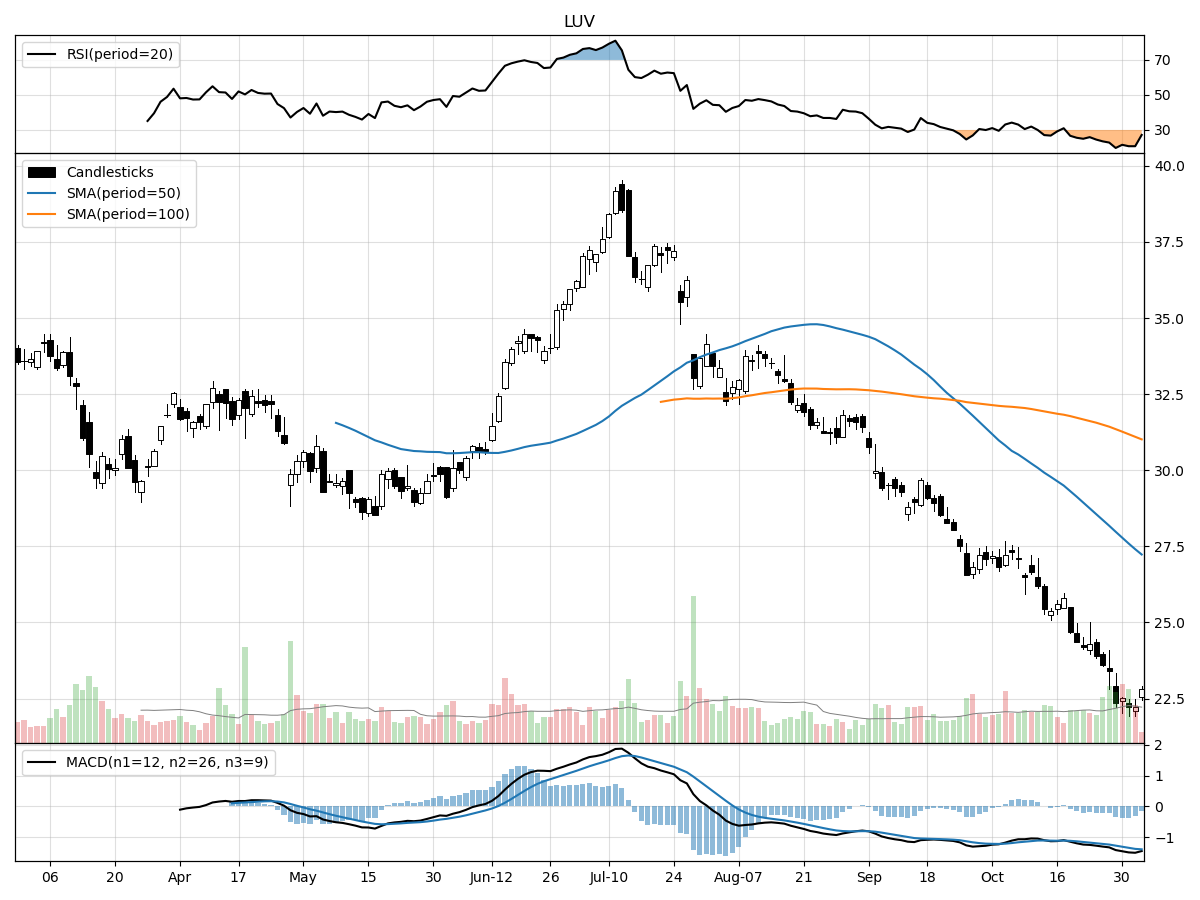Fly with Southwest Airlines?
Southwest Airlines Co (LUV),
November 17, 2023
(AI generated investment deep dive into a company of interest)
Company Overview
Southwest Airlines Co. is a major passenger airline operating primarily within the United States and ten near-international countries. As of December 2022, the company had a fleet of 770 Boeing 737 aircraft. The company saw a decline in passenger demand and revenues due to the COVID-19 pandemic, especially in business and international travel. However, the company has seen a recovery trend in domestic leisure travel demand in 2022. Southwest Airlines has also been working on optimizing its route network by adjusting frequencies, adding new markets, and eliminating less profitable flights.
The company operates on a low-cost model and uses a single aircraft-type strategy, mainly the Boeing 737s, to simplify management across various domains. They primarily serve secondary and downtown airports to achieve high asset utilization and employee productivity. The company also offers a variety of fare types and a customer loyalty program, Rapid Rewards, with various benefits. In 2021, they introduced Rapid Rewards for businesses, allowing companies to earn points that can be used for business travel. Southwest Airlines has been investing in customer experience enhancements, including improved WiFi connectivity, power ports on every seat on their MAX aircraft fleet, larger overhead bins, more variety in onboard entertainment, and self-service capabilities. They also launched the Southwest Business Assist™ in 2022, a business travel portal for better management of corporate travel.
Southwest Airlines has also undertaken several environmental sustainability initiatives to reduce its carbon footprint, including introducing fuel-efficient MAX aircraft, installing winglets for fuel efficiency, and implementing procedures for electric ground power usage. The company also differentiates itself through customer-friendly policies such as no-fee cancellation or change, and offering two free checked bags. Despite the negative impact of COVID-19, the company has resumed service to all 14 of its international destinations and began service in 14 new destinations in 2021.
By the Numbers
- 44.8% drop in net income to $539 million in 2022.
- 40.9% reduction in GAAP operating income to $1.02 billion in 2022.
- Record operating revenues of $23.8 billion in 2022, a 50.8% increase from 2021.
- Net loss of $220 million in Q4 2022 due to extreme weather.
- 27.7% increase in revenue passengers compared to 2021.
- Revenues per available seat mile (ASM) increased by 34.1% against 2021 and 12.5% in comparison to 2019.
- Operating revenue expected to increase by 20% to 24% in Q1 2023.
- ASM expected to increase by about 10% in Q1 2023.
- $50 million in principal expected to be retired related to a lease buyout transaction in Q1 2023.
- 770 Boeing 737 aircraft at the end of 2022, with approximately 100 Boeing 737 MAX deliveries expected in 2023.
- Negative revenue impact in the range of $300 million to $350 million in Q1 2023 due to an increase in flight cancellations and a deceleration in bookings.
- 21% increase in active full-time equivalent employees from the end of 2021 to the end of 2022.
- Starting hourly pay rates increased from $15 to $17 for certain workgroups.
- Passenger revenues increased by $7.3 billion, a significant 52.2% compared to 2021.
- Decrease in freight revenues by $10 million for 2022.
- Operating expenses in 2022 increased by 62.0% ($8.7 billion) from 2021.
- Other revenues for 2022 grew by 45.0% ($692 million) compared to 2021.
- Fuel and oil expenses increased by 80.5% compared to 2021.
- Fair value of fuel derivative contracts stands at approximately $512 million.
- Decrease in the maintenance expense by 0.2% or $2 million in 2022 compared to 2021.
- Landing fees and airport rentals increased by $52 million or 3.6%.
- Depreciation and amortization expenses increased by $79 million or 6.2%.
- Other operating expenses increased by a significant 56% or $1.3 billion in 2022 compared with 2021.
- Interest expense decreased by 27% or $127 million in comparison to 2021.
- Q3 2023 operational income decreased by 70.4% from $395 million to $117 million.
- Net income decreased by 30.3% from $277 million to $193 million in Q3 2023.
- 8.1% increase in revenue passengers carried for the nine months ending on September 30, 2023.
- 9% to 11% YoY decrease in RASM expected in Q4 2023.
- Approximately 21% YoY increase in ASMs expected in Q4 2023.
- Economic fuel costs per gallon estimated to be in the range of $2.90 to $3.00 in Q4 2023.
- CASM-X expected to drop 16% to 19% YoY in Q4 2023.
- Debt repayment of about $7 million scheduled in Q4 2023.
- Interest expenses projected at about $63 million in Q4 2023.
- ASMs expected to increase 14% to 15% YoY for the full year 2023.
- Economic fuel costs per gallon at $2.85 to $2.95 for the full year 2023.
- CASM-X expected to drop 1% to 2% YoY for the full year 2023.
- Scheduled debt repayments stand at approximately $85 million for the full year 2023.
- Interest expense forecast around $256 million for the full year 2023.
- Capital spending projected at roughly $3.5 billion for the full year 2023.
- 814 aircraft expected at the end of 2023.
- YOY Q3 2023 total operating revenue increase of $305 million.
- Passenger revenues increased by $299 million in Q3 2023.
- Operating expenses rose $583 million in Q3 2023.
- Operating expenses for the first nine months of 2023 increased by 14.8% or $2.4 billion compared to the first nine months of 2022.
- Passenger revenues increased by 9.8% or $1.6 billion during the first nine months of 2023.
- Maintenance materials and repairs increased by $122 million or 59.8% in Q3 2023 compared to Q3 2022.
- Landing fees and airport rentals increased by $62 million or 15.7% in Q3 2023 compared to Q3 2022.
- Depreciation and amortization increased by $40 million or 11.9% in Q3 2023 compared to Q3 2022.
- Other operating expenses increased by $139 million or 17.0% in Q3 2023 compared to Q3 2022.
- Interest expense decreased by $23 million or 26.7% in Q3 2023 compared to Q3 2022.
- Effective tax rate was 18.5% in Q3 2023, down from 21.6% in Q3 2022.
- Annual 2023 effective tax rate projected to be approximately 23%.
- Operating expenses increased by 2.1% in Q3 2023 compared to the first nine months of 2022.
- Salaries, wages, and benefits expense increased by $1.2 billion, or 18.0%, compared to the same period in the prior year.
- Fuel and oil expenses increased by $124 million, or 2.8%, in Q3 2023 compared to the first nine months of 2022.
- Maintenance materials and repairs increased by $212 million, or 34.0%, in Q3 2023 compared to the first nine months of 2022.
- Other operating expenses increased by $525 million, or 22.4%, in Q3 2023 compared to the first nine months of 2022.
- Effective tax rate decreased to 22.0% from 25.1% in the same period last year.
Stock Performance and Technical Analysis

The current stock price of the company stands at $22.82, marking a 2% increase from its 52-week low. This increase, while minor, suggests that the company is slowly recovering from its lowest valuation point within the last year, indicating a potential turnaround. However, it is also essential to note that its current price is 57% below its 52-week high, signaling that it has experienced a significant drop in its valuation. The price stability over the last month and quarter implies that the company's stock has been trading within a relatively narrow range, which may point to a lack of momentum in either direction.
The stock's volume metrics also paint a crucial picture. The recent daily volume stands at approximately 8.16 million shares, compared to a longer-term average of around 7.36 million shares. This increase in trading volume may indicate heightened investor interest in the company's stock. However, the interpretation of this metric largely depends on accompanying price movements. If the increased volume is coupled with a declining stock price, it may signal a bearish sentiment, with more investors selling off their holdings.
Lastly, the stock's MACD (Moving Average Convergence Divergence) value is at a bearish -1.39. A negative MACD value generally means that the 12-day EMA (Exponential Moving Average) is below the 26-day EMA, suggesting a downward price momentum and potentially signalling a sell-off. The Money Flow indicators also suggest that the stock is under heavy selling pressure and is being distributed, both of which could indicate a bearish sentiment among investors.
In conclusion, while the company shows minor positive signs of recovering from its 52-week low, other metrics such as the MACD and Money Flow indicators suggest a bearish sentiment. The increased trading volume could also indicate a sell-off if accompanied by a declining stock price. Therefore, this would warrant a cautious approach when considering investing in this company.

The ‘Bull’ Perspective
- Southwest Airlines has shown a consistent increase in the number of revenue passengers, indicating a recovering demand in the aviation sector.
- The company has made strategic investments in fuel-efficient aircraft, enhancing its operational efficiency and sustainability.
- The enhancement of its Rapid Rewards loyalty program is expected to boost customer retention and engagement.
- Despite increased operating expenses, the company has managed to increase its passenger revenues, demonstrating strong financial resilience.
- The company's effective tax rate has decreased, providing a boost to its bottom line.
Recovering Demand in the Aviation Sector:
Southwest Airlines reported an 8.1% increase in revenue passengers for the nine months ending on September 30, 2023, indicating a recovery in the demand for air travel. While the global aviation industry was severely hit by the COVID-19 pandemic, the steady increase in passengers carried by Southwest Airlines suggests a rebound. The company's Q4 2023 outlook includes a 9% to 11% YoY decrease in RASM, but a significant 21% YoY increase in ASMs, further underscoring the recovering demand.
Strategic Investments in Fuel-Efficient Aircraft:
Southwest Airlines has made a strategic decision to retire older aircraft and invest in more fuel-efficient models. The company has placed an order for 573 MAX aircraft from Boeing for delivery between 2023 and 2031. This move not only enhances the company's operational efficiency but also aligns with global sustainability goals. Given the volatility in fuel prices, this investment could yield significant cost savings in the long run.
Enhancement of Rapid Rewards Loyalty Program:
The company has enhanced its Rapid Rewards loyalty program, planning to accept a combination of cash and points for flight payments starting from spring 2024. This move is likely to boost customer retention and engagement, driving more consistent revenue streams. Loyalty programs have been a proven strategy in the aviation industry to cultivate customer loyalty and increase repeat business.
Increase in Passenger Revenues Despite Increased Operating Expenses:
Despite a 14.8% increase in operating expenses for the first nine months of 2023, Southwest Airlines managed to increase its passenger revenues by 9.8% during the same period. This demonstrates the company's strong financial resilience and ability to navigate increased costs. The increase in revenues was mainly attributed to a surge in both leisure and business travel demand and a 12.5% uptick in capacity.
Decreased Effective Tax Rate:
The company's effective tax rate decreased to 22.0% from 25.1% in the same period last year, primarily due to the absence of losses on convertible debt repurchases. A lower tax rate provides more room for the company to reinvest in its operations or return capital to shareholders, providing a boost to its bottom line.
In conclusion, despite the challenges posed by the ongoing pandemic and increased operating expenses, Southwest Airlines has demonstrated strong resilience and strategic foresight. Its investments in fuel-efficient aircraft and enhancements to its loyalty program, coupled with a recovering demand for air travel and a decrease in its effective tax rate, make a compelling case for investment in the company.

The ‘Bear’ Perspective
Why Southwest Airlines Co. (LUV) Stock Is a No-Fly Zone
Summary:
- Operational income and net income have seen a significant decrease.
- Increased operating expenses, particularly in salaries, wages, and benefits.
- The company's reliance on single suppliers and third-party service providers pose a risk.
- Workforce-related challenges due to the COVID-19 pandemic have impacted the company's ability to maintain optimal staffing levels.
- The company's heavy reliance on technology presents a risk of significant disruption or breach.
- Decrease in Operational and Net Income
Southwest Airlines Co.'s Q3 2023 report shows a concerning decrease in operational and net income. Operational income decreased by a staggering 70.4% from $395 million to $117 million, and net income decreased by 30.3% from $277 million to $193 million. This decrease is largely attributed to the financial impact of the operational disruption in December 2022 on the Q1 2023 results, which was approximately $380 million on a pre-tax basis. A continued decrease in these key financial metrics could spell trouble for the company's overall financial health.
Increased Operating Expenses
The company's operating expenses have been on the rise, particularly in salaries, wages, and benefits. For the first nine months of 2023, operating expenses increased by 14.8% or $2.4 billion compared to the same period in 2022. Salaries, wages, and benefits expense alone increased by $1.2 billion, or 18.0%. This rise in operating expenses, especially in a time when operational and net income are decreasing, could squeeze the company's margins and profitability.
Reliance on Single Suppliers and Third-Party Service Providers
Southwest Airlines' reliance on single suppliers for aircraft parts and engines, as well as third-party service providers, poses a significant risk. Any disruptions in the supply chain could lead to severe operational disruptions, affecting the company's ability to maintain its flight schedules and meet customer expectations. This reliance also places the company at the mercy of these suppliers and providers, who could increase prices or fail to deliver, impacting Southwest's bottom line.
Workforce-Related Challenges
The ongoing COVID-19 pandemic has presented workforce-related challenges for Southwest Airlines. The company has struggled to maintain optimal staffing levels, leading to an additional expense of $96 million related to the contract ratification bonus. If these challenges persist, the company could face further operational disruptions and increased costs.
Heavy Reliance on Technology
Southwest Airlines' heavy reliance on technology presents a significant risk. The company has experienced material technology system interruptions and delays in the past that have affected the efficiency of its operations. Any potential disruptions or breaches in its information system could have a significant impact on its operations, customer satisfaction, and overall reputation.
In conclusion, while Southwest Airlines Co. has shown some positive growth trends, the company is facing significant challenges. The decrease in operational and net income, coupled with increased operating expenses and various risks, paints a bearish picture for the stock. Investors should approach with caution.




Comments ()